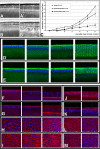Overlapping functions of argonaute proteins in patterning and morphogenesis of Drosophila embryos
- PMID: 16934003
- PMCID: PMC1557783
- DOI: 10.1371/journal.pgen.0020134
Overlapping functions of argonaute proteins in patterning and morphogenesis of Drosophila embryos
Abstract
Argonaute proteins are essential components of the molecular machinery that drives RNA silencing. In Drosophila, different members of the Argonaute family of proteins have been assigned to distinct RNA silencing pathways. While Ago1 is required for microRNA function, Ago2 is a crucial component of the RNA-induced silencing complex in siRNA-triggered RNA interference. Drosophila Ago2 contains an unusual amino-terminus with two types of imperfect glutamine-rich repeats (GRRs) of unknown function. Here we show that the GRRs of Ago2 are essential for the normal function of the protein. Alleles with reduced numbers of GRRs cause specific disruptions in two morphogenetic processes associated with the midblastula transition: membrane growth and microtubule-based organelle transport. These defects do not appear to result from disruption of siRNA-dependent processes but rather suggest an interference of the mutant Ago2 proteins in an Ago1-dependent pathway. Using loss-of-function alleles, we further demonstrate that Ago1 and Ago2 act in a partially redundant manner to control the expression of the segment-polarity gene wingless in the early embryo. Our findings argue against a strict separation of Ago1 and Ago2 functions and suggest that these proteins act in concert to control key steps of the midblastula transition and of segmental patterning.
Conflict of interest statement
Competing interests. The authors have declared that no competing interests exist.
Figures








Similar articles
-
Natural variation of the amino-terminal glutamine-rich domain in Drosophila argonaute2 is not associated with developmental defects.PLoS One. 2010 Dec 17;5(12):e15264. doi: 10.1371/journal.pone.0015264. PLoS One. 2010. PMID: 21253006 Free PMC article.
-
Distinct roles for Argonaute proteins in small RNA-directed RNA cleavage pathways.Genes Dev. 2004 Jul 15;18(14):1655-66. doi: 10.1101/gad.1210204. Epub 2004 Jul 1. Genes Dev. 2004. PMID: 15231716 Free PMC article.
-
Sorting of Drosophila small silencing RNAs partitions microRNA* strands into the RNA interference pathway.RNA. 2010 Jan;16(1):43-56. doi: 10.1261/rna.1972910. Epub 2009 Nov 16. RNA. 2010. PMID: 19917635 Free PMC article.
-
The making of a maggot: patterning the Drosophila embryonic epidermis.Curr Opin Genet Dev. 1994 Aug;4(4):529-34. doi: 10.1016/0959-437x(94)90068-e. Curr Opin Genet Dev. 1994. PMID: 7950320 Free PMC article. Review.
-
Drosophila development: RNA interference ab ovo.Curr Biol. 2004 Jun 8;14(11):R428-30. doi: 10.1016/j.cub.2004.05.036. Curr Biol. 2004. PMID: 15182691 Review.
Cited by
-
From the Argonauts Mythological Sailors to the Argonautes RNA-Silencing Navigators: Their Emerging Roles in Human-Cell Pathologies.Int J Mol Sci. 2020 Jun 3;21(11):4007. doi: 10.3390/ijms21114007. Int J Mol Sci. 2020. PMID: 32503341 Free PMC article. Review.
-
Endogenous small interfering RNAs in animals.Nat Rev Mol Cell Biol. 2008 Sep;9(9):673-8. doi: 10.1038/nrm2479. Nat Rev Mol Cell Biol. 2008. PMID: 18719707 Free PMC article. Review.
-
Regulation of the Rac GTPase pathway by the multifunctional Rho GEF Pebble is essential for mesoderm migration in the Drosophila gastrula.Development. 2009 Mar;136(5):813-22. doi: 10.1242/dev.026203. Epub 2009 Feb 11. Development. 2009. PMID: 19176590 Free PMC article.
-
Genome-wide exonic small interference RNA-mediated gene silencing regulates sexual reproduction in the homothallic fungus Fusarium graminearum.PLoS Genet. 2017 Feb 1;13(2):e1006595. doi: 10.1371/journal.pgen.1006595. eCollection 2017 Feb. PLoS Genet. 2017. PMID: 28146558 Free PMC article.
-
P-body formation is a consequence, not the cause, of RNA-mediated gene silencing.Mol Cell Biol. 2007 Jun;27(11):3970-81. doi: 10.1128/MCB.00128-07. Epub 2007 Apr 2. Mol Cell Biol. 2007. PMID: 17403906 Free PMC article.
References
-
- Meister G, Tuschl T. Mechanisms of gene silencing by double-stranded RNA. Nature. 2004;431:343–349. - PubMed
-
- Bernstein E, Caudy AA, Hammond SM, Hannon GJ. Role for a bidentate ribonuclease in the initiation step of RNA interference. Nature. 2001;409:363–366. - PubMed
-
- Hutvagner G, McLachlan J, Pasquinelli AE, Balint E, Tuschl T, et al. A cellular function for the RNA-interference enzyme Dicer in the maturation of the let-7 small temporal RNA. Science. 2001;293:834–838. - PubMed
-
- Hammond SM, Bernstein E, Beach D, Hannon GJ. An RNA-directed nuclease mediates post-transcriptional gene silencing in Drosophila cells. Nature. 2000;404:293–296. - PubMed
Publication types
MeSH terms
Substances
Associated data
- Actions
Grants and funding
LinkOut - more resources
Full Text Sources
Molecular Biology Databases

